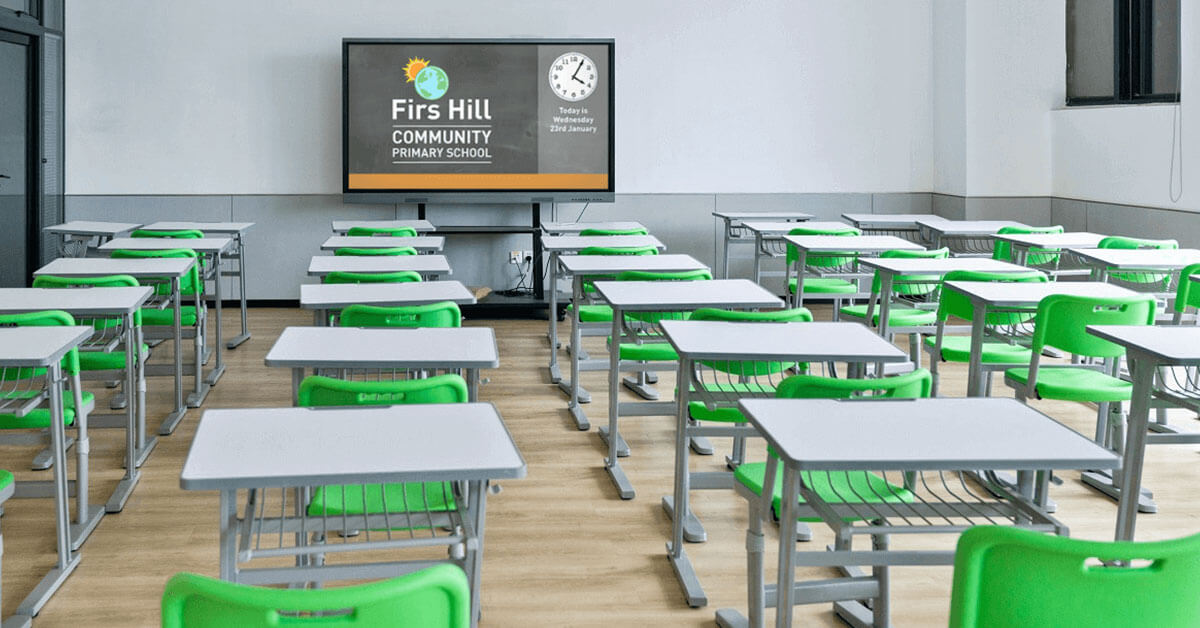Digital signage in education? Been there, done that, and it totally works. Digital signage created by students? That’s a new one.
We promise it’s just as effective and necessary though. After all, the more power and tech students get to communicate, the more engaged and creative they’ll be.
Here’s how and why digital signage created by and for students is an excellent choice for schools.
What benefits does digital signage created by students provide?
The benefits of digital signage in schools are numerous. But what happens when the educational content is created by the students themselves? Teens love social media. In fact, the latest study shows teens prefer communicating through tech like social media and texting compared to face-to-face interaction. Which is great, because digital signage is all about using videos, images and tech to get your message and important information across.
The problem is that about 50% of those same teens also get frustrated with phubbing , and recognize that it takes a toll on their personal relationships. Makes sense. Everyone wants to feel heard and seen in real life. But what does that have to do with digital signage?
If used intelligently, digital signage created by students can harness teens’ love of tech while forging interpersonal connections. Hand control of digital signage over to students, and schools just might have a great tool in their arsenal. A user-friendly interface combined with easy-to-use school apps for digital signage allows every student to create their own content, no matter how tech-savvy they are.
Here are some ideas for educational institution signage that puts students in the driver’s seat.
Digital signage created by students forges interdisciplinary connections
It’s often hard to get different student groups to mix. I mean, science whizzes don’t always hang out with theater kids. And it’s sad. Because they’ve got a lot to learn from each other. And they just might bond enough to create new friendships.
Educational facilities can use student-run school digital signage to build those bridges. STEM students can set up digital signage video walls , install screens, and hook up players. Yodeck uses the Raspberry Pi and that means tech-savvy students can manually configure the player and test their skills. Newspaper and journalism students can then create daily tickers with school news. Bring art and photography students on board to create photos, images, videos, and text slides. And don’t forget to have English students do the editing. Keep those STEM kids involved by having them provide ongoing tech support and a signage solution.
Digital signage in schools improves student satisfaction while getting them to collaborate on entertaining group projects.
Student-run digital sign strengthens school spirit and community
People traditionally use digital signage software to advertise sales and strengthen a company’s brand. Seems like it’s way too corporate for student life and educational signage, doesn’t it? Not so.
Have students create content for a digital signage social media wall to advertise a club upcoming event, school plays, musicals and concerts. And don’t forget to have teens to use a digital screen as a way of boosting school sports teams, homecoming and prom ticket sales and yearbook preorders.
Not only does digital signage in schools save money and the environment by eliminating the need for flyers, it’s also more effective. Why? Because if students create their own campaigns to promote school spirit and community school events, teens will definitely take the bait. And respond positively to the message. There’s no better way to boost student engagement than if the target viewer is also the one designing the content and campaign.
Digital signage created by students showcases what’s important to them
We all remember taking boring class photos and club portraits. All you did was sit there and hope you weren’t having a bad hair day. But those stilted images didn’t capture what student life was truly about. What we cared about. What we wanted to show the world about our life.
So why not have the students themselves immortalize what’s truly important to them? Use digital signage created by students to showcase school life, from their perspective. Students can take their own photos for Spirit Week and senior events. With the help of free school signage templates, they can highlight their favorite moments of school plays, recitals and class field trips. And who’ll do a better job immortalizing the excitement of Friday Night Lights and homecoming, admissions successes and NHS inductions?
Student-run digital signage content will definitely grab the hearts and minds of parents. What better way to show off student achievements during parent-teacher conferences than a highlights reel created by students?
Academic fairs and events can use digital signage created by students
Science fairs are cut-throat. Model United Nations is do-or-die. Debate championships require nerves of steel. Why not use digital signage created by students to give your school a boost?
Students can use digital signage in their science fair booths to wow the judges. And screens at local MUN conferences can keep delegates, secretariat and students up to date. Why not do a live video stream of committee and General Assembly meetings? And student council could definitely use the power of digital signage too. Students can use screens to present their platform during elections, communicate the meeting’s agenda and ask for feedback from the student body.
But what about the cost? Is it truly worth it?
Digital signage created by students is definitely not expensive. Yodeck for instance offers extremely affordable pricing plans with free players . And just think of all the benefits that come with it. Collaborating to create a digital signage strategy for the school fosters friendships, new bonds, creativity, commitment, community and so much more. Just by putting the power of student communication and tech in the hands of teens.
